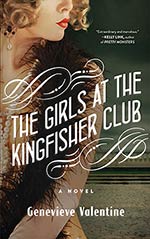
![]() FeminineFantastique
FeminineFantastique
6/15/2014
![]()
Genevieve Valentine's 2014 novel The Girls at the Kingfisher Club is a retelling of the fairy tale "The Twelve Dancing Princesses," my favorite story as a little kid. I'm not sure why I loved it so much — perhaps it's because the setting, with the trees of silver and gold and diamonds, is so ethereal. As an adult though, my feminist nature has problems with the original Brothers Grimm version. I mean, the princesses' fun (and agency) ends when they are caught. Patriarchy triumphs.
As Valentine tells it, this is a story of twelve sisters who have been confined to live in the attic by their overbearing father, as they represent his embarrassment at failing to sire a male heir. Fed up with their cloistered lives, they seek secret escape in the dance halls of 1920's New York City. The oldest, Jo — or "the General," as she is referred to by her sisters — assumes a sort of guardianship over the eleven younger ones, and it is through her eyes that this story is told. But surprisingly, while it is at times difficult to keep track of who is who, all of the sisters have distinct personalities: bold Louise, demure Ella, irreverent Doris (my favorite), and the others.
The sisters grow and change. Louise finds a heart, Ella finds her strength, and Doris finds what she can take seriously. Eventually they also find a home within the Kingfisher Club; they befriend the bartender and patrons without ever divulging their real names and establish a set of protocols for their safety. They defend each other from handsy dance partners, from capture, and from the perils of heartbreak.
But the girls' clandestine nocturnal outings become more and more dangerous. The police raid the club. Jo encounters the one man from her past that makes her vulnerable. As the notoriety of the twelve dancing princesses grows, their father suspects that they are his daughters. But the girls don't stop, because it's really a choice between living and dying. And it's when Jo, torn between duty and desire, loses her staid stewardship and gives into wild abandon that the story moves towards its spellbinding climax and bittersweet resolution.
The setting of The Girls at the Kingfisher Club recreates the same mystique of the one from the fairy tale, albeit with the glamor and taboo of Prohibition-era dance halls rather than enchanted forests and lakes. That's rather remarkable, particularly since the setting is NYC, which is the setting for (made up number) 65% of all novels ever. For the characters the city is as enigmatic as the cosmos are to us. In this novel, the underbelly of 1920's New York becomes a character unto itself, in all its wildness and danger.
Even more poignant is the portrait of the relationships between sisters. I've long looked for another SF/F book at all like Alma Alexander's The Secrets of Jin-Shei, one with similar themes — of love and loyalty, of heartbreak and betrayal, and of the bonds of sisterhood. A sormance, if you will. I've spent a decade trying to find another novel that captures that kind of magic.
Valentine's book does it. The Girls at the Kingfisher Club is a feminist transformation of my favorite fairy tale. And it's the version that I'll henceforth remember.
http://manicpixiedreamworlds.wordpress.com/